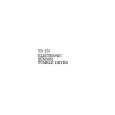No hay comentarios de productos.
Audio Adjust (Advanced)�Continued
c. Dolby Digital EX (Dolby D) If you have surround back speakers connected, use this setting to select whether or not you will use Dolby EX playback. Auto: When the source has an EX �ag (ID signal for Surround EX), the playback is automatically changed to Dolby Digital EX. If the source has no EX �ag, the playback is changed to Dolby Digital. On: The playback is set to Dolby Digital EX. Off: The playback is set to normal Dolby Digital. If your surround channel is monaural or you do not have a surround channel, then the playback will be normal Dolby Digital regardless of the above setting. You can easily change the Dolby Digital EX mode settings using the remote controller. While playing a Dolby Digital source, after displaying the current listening mode with a press of the Surround button, each press of the Surround button on the remote controller cyclically changes the Dolby Digital EX mode in the order of �Auto,� �On,� and �Off.� d. DTS-ES This setting selects the DTS-ES mode. Auto: Select to have the listening mode change automatically to DTS-ES Discrete or DTS-ES Matrix when the DTS source has the DTS-ES �ag (ID signal for DTS-ES). If the DTS source has no DTS-ES �ag, the mode is changed to DTS 5.1. On: Select to have the listening mode change automatically to DTS-ES Discrete or DTS-ES Matrix when the DTS source has the DTS-ES �ag, and to DTS + Neo:6 when the DTS source has no DTS-ES �ag. Off: Select to not use DTS-ES listening modes even when the DTS source has the DTS-ES �ag. With this setting, the DTS sources are always played in DTS 5.1 mode. You can also easily change the DTS-ES mode settings using the remote controller. While playing a DTS source, after displaying the current listening mode with a press of the Surround button, each press of the Surround button on the remote controller cyclically changes the DTSES mode in the order of �Auto,� �On,� and �Off.� e. Pro Logic II Music Panorama Use this setting to extend the front stereo image to include the surround speakers for an exciting wraparound effect with side wall imaging. On: Select to turn on the PL II Music Panorama mode. Off: Select to turn off the PL II Music Panorama mode. f. Pro Logic II Music Dimension Use this setting to gradually adjust the sound�eld forward or backward. It varies between 0 and 6 in steps of 1 and the default value is 3. The setting of �3� is the normal position. Change the setting to �2� or lower to move the sound space forward and setting to �4� or higher to move the sound space backward. If the stereo recording has excessive broadness or a too strong surroundness, move the sound space forward to get the appropriate sound balance. In contrast, if the stereo recording feels somewhat like monaural or has narrowness, move the sound space backward to get more surroundness. g. Pro Logic II Music Center Width In Pro Logic II decoding, center signals are output from the center speaker. When the center speaker is not used, the decoder will divide the center signal equally to both the front left and right speakers to create a �phantom� center sound image. The Pro Logic II Music Center Width mode allows you to adjust from where the center sound image is heard. Using this, you can have the sound�eld be heard from the center speaker only, from the front left and right speakers only (as a phantom center sound image), or from all three speakers (center, front left and right) in various level combinations. The sound�eld varies between 0 and 7 in steps of 1 and the default value is 3. For home use, applying some width to the center signal will improve the level balance for the center and main speakers, and will effect the width of the center sound image, or �weight� of the sound. Many sound recordings processed for stereo playback will be reproduced better by proper control of this setting. The recommended setting for Pro Logic II Music mode is �3.� This allows you to easily distinguish the Pro Logic II Music mode from the Pro Logic II Movie mode whose setting is automatically set to �0.� h. Center Image DTS Neo:6 derives a center channel from 2 channel PCM and analog sources. In the cinema mode, for Lt/Rt �lm soundtracks, sounds steered to the center are subtracted from the left and right channels. In the music mode, the intent in the front channels is less one of steering and more one of stabilizing the front image by augmenting it with a center channel, while preserving the original perspective of the stereo mix. Therefore, the derived center is never fully subtracted from the left and right channels. Center Image is the factor controlling the amount of subtraction. It varies between 0 and 5 in steps of 1 and the default value is 3. When Center Image=5, the factor is zero and nothing is subtracted from the left and right channels. When Center Image=0, the center channel is subtracted from the left and right channels at half level (�6 dB) for each channel. The signal level sent to the center channel output is not affected by Center Image. This control should be set based on room layout and personal preferences. A setting of 5 allows the left and right channels to pass through unaltered from the stereo mix. A setting of 0 gives more center channel dominance, which is particularly desirable if listeners are located well off-center. At any setting, the center speaker anchors the image. Center Image is only enabled when the listening mode is DTS Neo:6 Music.
60

